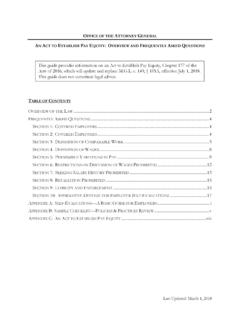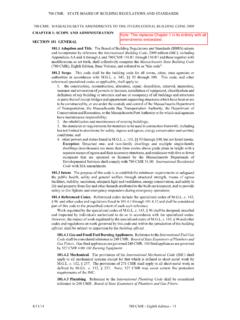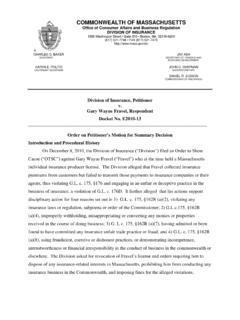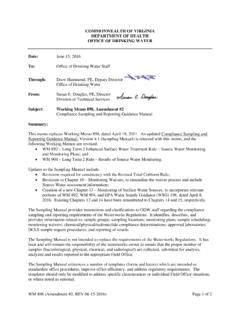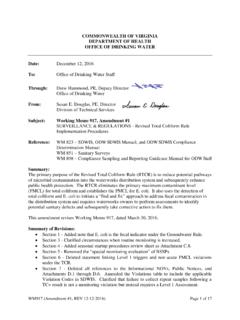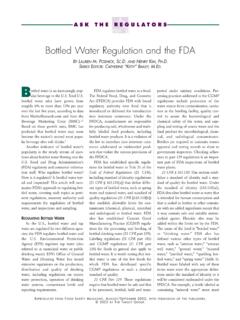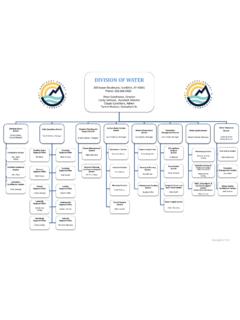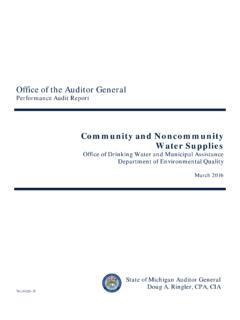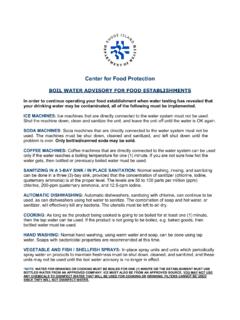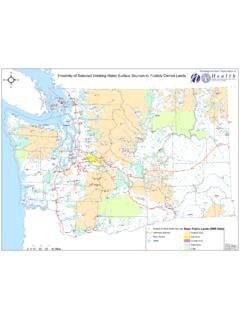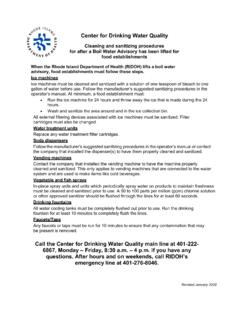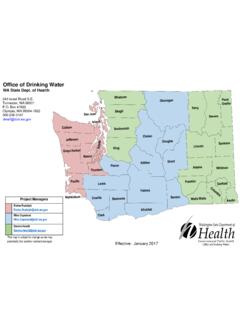Transcription of Massachusetts Department of Environmental Protection ...
1 Massachusetts Department of Environmental Protection office of Research and Standards Final Recommendations for Interim Toxicity and drinking water Guidance Values for Perfluorinated Alkyl Substances Included in the Unregulated Chemical Monitoring Rule 3. June 8, 2018. Summary and Recommendations The United States Environmental Protection Agency (USEPA) included six perfluorinated alkyl substances (PFAS) in the Unregulated Contaminant Monitoring Rule 3 (UCMR 3) (77 FR. 26072, 2012). Under UCMR 3 many public drinking water supplies across the US, including in Massachusetts (MA), were tested for a number of emerging contaminants of concern. The UCMR 3 PFAS compounds included perfluorooctane sulfonate (PFOS), perfluorooctanoic acid (PFOA), perfluorohexane sulfonate (PFHxS), perfluorononanoic acid (PFNA), perfluorohepatanoic acid (PFHpA) and perfluorobutane sulfonate (PFBS).
2 All of the UCMR 3 PFAS have been detected in one or more MA water supplies, as well as in some groundwater and surface water samples. Because USEPA has only issued drinking water health advisory (HA) values and toxicity values (Reference Doses or RfDs) for PFOS and PFOA, the Massachusetts Department of Environmental Protection (MassDEP) drinking water and Waste Site Cleanup Programs requested the office of Research and Standards (ORS). assistance in evaluating the potential health risks associated with detections of the other four UCMR 3 PFAS. Currently, USEPA, MA and most other states do not address the additional UCMR 3 PFAS analytes in drinking water guidance or risk assessments. This is tantamount to a default assumption that these compounds are not toxic and do not present any additional health risk.
3 In light of the structural similarities of these compounds; available data relating to biological half-lives, which are long; and toxicity, which includes developmental endpoints, it is not reasonable or health-protective to treat these compounds as being non-toxic. The following document presents ORS recommendations regarding how health risks posed by these compounds should be evaluated based on a review of key information relating to their toxicity, chemical structures and biological persistence. In summary, the available data demonstrate that PFHxS, PFNA and PFHpA are very similar in molecular structure to PFOS and PFOA, with all three compounds having six to eight fluorinated carbons (plus or minus one compared to PFOS and PFOA).
4 They also exhibit similarly long This information is available in alternate format. Contact MassDEP's office of Diversity/Civil Rights at 617-292-5751. TTY# MassRelay Service 1-800-439-2370. MassDEP Website: Printed on Recycled Paper biological half-lives ranging from approximately 3-7 years, which is strongly associated with the toxicity of these compounds. Although toxicity test data are more limited for the three additional compounds compared to PFOS and PFOA, the available results demonstrate that these compounds elicit similar types of effects and these are observed at similar dose ranges. PFBS has only four fluorinated carbons, and available data, although limited, indicates that it exhibits lower toxicity than PFOS and PFOA and is less persistent in the body, with a serum half-life of weeks compared to years for PFOS and PFOA1.
5 The USEPA has issued a provisional RfD, but no drinking water guidance, for PFBS, and the Minnesota Department of Health (MNDH). recently issued a revised drinking water guidance value of 2,000 ppt for this compound. Based on the information reviewed by ORS and to address the gaps in guidance from USEPA. regarding toxicity and drinking water guidance values for PFHxS, PFNA, PFHpA and PFBS, ORS: a. Recommends that the USEPA HAs and RfDs derived for PFOS and PFOA be applied to PFHxS, PFNA and PFHpA. b. Recommends that an additive toxicity approach be used for these compounds when they occur together. For example, when all or some of the five compounds PFOS, PFOA, PFHxS, PFNA and PFHpA occur together in drinking water , the detected concentrations for these PFAS should be summed and compared to ug/L (70 ppt).
6 C. Does not recommend treating PFBS as being equipotent to the longer-chain PFAS. considered in this document and is further assessing appropriate toxicity and drinking water guidance values for this compound. In the interim, the MNDH drinking water guidance value of 2 ug/L (2,000 ppt) and RfD ( mg/kg-day) are recommended for PFBS for risk screening purposes pending further ORS review. The recommendation regarding additivity of PFHxS, PFNA and PFHpA, with PFOS and PFOA, is an extension of the approach used by USEPA for PFOS and PFOA, which treats these two compounds as being toxicologically equivalent and additive. Extending this approach and applying the PFOS and PFOA RfD and HA values to the other longer-chain UCMR 3 PFAS is supported by the similarities in molecular structures, toxicology and serum half-lives exhibited by these five compounds.
7 This approach is consistent with that used by the Connecticut (CT) Department of Public Health (CTDPH) in establishing the CT drinking water Action Levels for the UCMR 3 PFAS (CT. DPH, 2016) and is further supported by stated concerns and decisions about long-chain PFAS. 1. With respect to the other USEPA Method 537 PFAS, PFHxA has been found to be considerably less toxic and persistent than PFOS and PFOA. Very little in vivo data was located on C10 and longer chain PFAS included in EPA Method 537. These longer compounds exhibit greater cytotoxicity in in vitro bioassays but there are considerable uncertainties regarding their toxicokinetics and indications that they may not be as well absorbed following ingestion. At this time, no RfD or HA values have been issued or proposed for these compounds by USEPA or ORS.
8 MassDEP office of Research and Standards June 8, 2018. risks by: 1) USEPA (USEPA, 2017a); 2) the Arizona Department of Health Services (AZDHS). and the Agency for Toxic Substances and Disease Registry (ATSDR), Health Consultation on the Ottoman water Company (Arizona DHS, 2016); and, 3) the Colorado Department of Public Health and Environment (CODPHE) and USEPA Region 8 decision to include PFHpA together with PFOA and PFOS in their assessment of contaminated drinking water near Colorado Springs, CO (CODPHE, 2017). Due to the lack of USEPA drinking water guidance and toxicity values for several of the UCMR. 3 PFAS, the potential risks of these compounds to sensitive populations, in particular the developing fetus and nursing infants may not be adequately addressed.
9 The proposed recommendations fill this gap by providing clear drinking water guidance and toxicity values. As information is evolving on PFAS toxicity and exposures, ORS will continue to track scientific developments on these compounds, in particular regarding potential mechanisms of action that may further improve the understanding and extrapolation of effects in animals to humans, and will update these recommendations as appropriate. Introduction and Background PFAS are a group of man-made fluorinated chemicals containing diverse functional groups and carbon chain lengths. They are known to be persistent and bioaccumulative, explaining their worldwide Environmental presence. To begin to gather data on the occurrence of PFAS.
10 Compounds in US drinking water , six of these compounds were included in USEPA's nationwide testing of public drinking water supplies (PWS) under the Unregulated Contaminant Monitoring Rule 3 (UCMR 3) (Table 1). Under this program all large public water systems and some smaller systems were tested for six PFAS compounds. In MA, 170 PWS were sampled for the six PFAS. This testing is required under the Safe drinking water Act. The six compounds included PFOS, PFOA, PFHxS, PFNA, PFHpA and PFBS. All of these compounds have been detected at some level in one or more MA water supplies2. USEPA has established identical toxicity values (reference doses or RfDs), of mg/kg/day for PFOS and PFOA (USEPA 2016 a,b). USEPA also issued drinking water Health Advisories (HA) of ug/L (70 ppt) for PFOS and PFOA (USEPA, 2016a,b).
